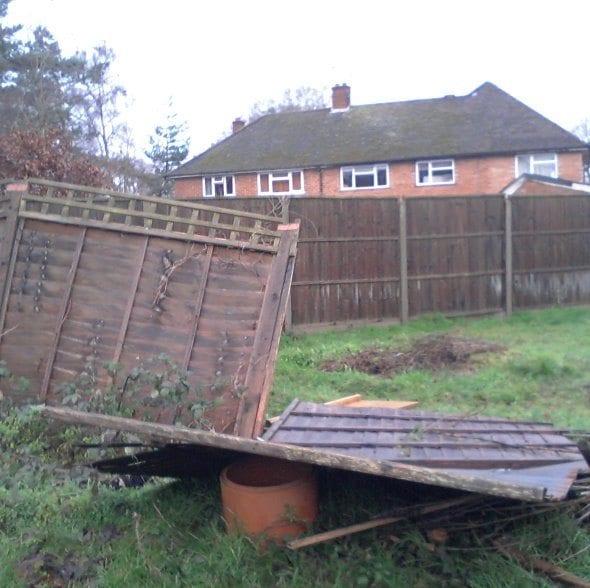If over the last few weeks you have been affected by the storms and gale force winds it is likely the extreme weather has wreaked havoc on your garden. Fence fatalities and fallen trees are commonplace but don’t panic! Here landscape gardener Ryan Jenkins from RJJ Gardening offers some expert advice on how best to deal with storm damage.
Firstly assess the damage… If fence panels have succumbed to the gale force winds they’ll need to repaired or replaced and fallen down tress cleared. When it comes to fences the good news is there’s a 50 / 50 chance it will be your neighbour’s responsibility rather than your own. The fence to the left-hand side of your garden is usually yours to maintain but check your deeds to know for sure.
Once you know what you’re dealing with your first course of action should be to contact your house insurance company. Nine times out of ten you will be covered for fallen trees or indeed if any fallen fence panels pose a security risk to your property. If this is the case it’s in the insurers’ best interests to get the problem fixed as quickly as possible and they will usually have their own contractors.
If it’s a fence post you’re dealing with that’s not covered by your insurance then, as long as there’s no security risk, hold off fixing it for a week or so as there’s no point mending the fences while the storms and floods continue.
Repair or replace? Although on first inspection it may look like you could repair a fallen post, the below-ground damage usually means it’s better to replace than repair. The reason being, over the course of a few years soil and water erode and weaken the fence posts leading to fractures, which when compounded with the recent winds can become severely cracked and damaged. In the long term it is better to replace.
If you’re a keen diy-er then you can attempt to replace the posts yourself. To do the job properly you’ll need to be equipped with the right tools to help with the tougher parts of the job including the removal of the existing concrete. It’s not a one-man job. You’ll need someone to lend you a hand … unless you want to turn yourself into a human kite, which I wouldn’t recommend.
When you are resetting the fence posts you need to ensure you get the post far enough into the ground (around 2-3 feet). Secure the posts with concrete to make sure they don’t come a cropper again next time the wind picks up.
When it comes to the actual fence panels, if they have already served you well for a number of years it’s likely they’ve had their day and should be replaced. Expect to pay £20 for a 6ft x 6ft panel and with proper aftercare and application of a fence protection treatment should last around 10 years.Fence posts cost £12 – £15 per post depending on the thickness.
If you’re not a Handy Andy or simply don’t have the time to get out there and do the job yourself, then get an expert in who will do a professional job. For a standard two panel fence replacement (i.e. 3 x posts and 2 x panels) then expect to pay around £200 – £250 for parts and labour. Remember to check with the contractor whether removal of old fence posts and panels is included in the price as this can sometimes be at an additional cost.
The sheer volume of rain we have had over the last couple of weeks means it’s likely there will be general water damage to your garden. There’s not much you can do at this stage and my best advice is to hold tight and wait for better weather. You could fork the grass to encourage the water to drain away but if it’s really wet underfoot you’ll end up causing more damage than if you just leave it be.
If you are really fed up with your lawn turning into a muddy quagmire then perhaps now is the time to consider switching to artificial grass. It will stay looking great all year round come rain or shine – even when all around it is in disarray!
Once the fences are fixed and fallen trees are cleared leave the garden and wait until spring arrives before getting back out there.



